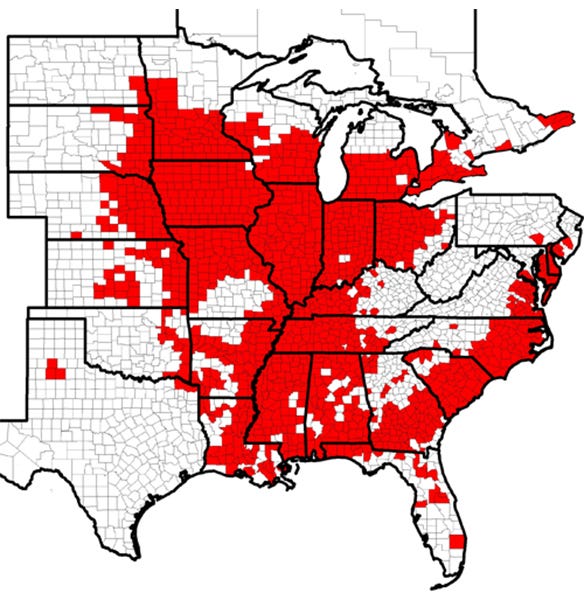
Brett Craigmyle makes a beeline for the shorter, stunted soybeans in a low-lying area of the field. Visual signs point to the possibility of disease, and below the surface, the Syngenta agronomist says there is a strong presence of soybean cyst nematodes.
According to Craigmyle, it's often difficult for farmers to identify fields with SCN infestations. "The damage is belowground," he says, "not noticeable by the naked eye." But when farmers see visible changes in leaf color, wilting or dying plants due to sudden death syndrome, they tend to take notice. Craigmyle says to start sampling there for SCN.
How widespread is SCN?
Last year the agronomist pulled five different soil samples where SDS was present in a field. Every sample came back from the laboratory with SCN presence. "That's 100% of fields with sudden death syndrome that also had soybean cyst nematodes," he says. "That is telling. But in reality, SCN is in more soybean fields than are ever tested."
Craigmyle says all it takes is looking at a U.S. production map. "Anywhere you see soybeans growing on the map, there have been SCN detected within those regions," he adds. "We know we have the pest; it is a matter of to what degree or to what extent."

SCN BY STATE: This map shows the distribution of SCN by county in 2014.

SCN is a damaging pest that costs U.S. soybean farmers $1.2 billion annually. There were 89.5 million acres planted to soybeans in 2017. That means on average, SCN costs soybean farmers $13.41 an acre.
Unfortunately, a 2016 University of Missouri study shows that only 34% of farmers in the state considered SCN a problem or were aware of its presence in their fields. Only 31% of farmers knew how they were trying to protect their fields. Yet 92% of the soil samples tested were positive for SCN, with 77% of those rated as a medium or high infestation. That indicates a major problem when it comes to managing this pest.
What to look for
SCN is a small plant-parasitic roundworm that attacks the roots of soybeans. It is visible only with a magnifying glass. The nematode feeds on the plant's vascular system, making it vulnerable to other secondary infections.
The problem, according to Craigmyle, is that the female nematode reproduces very quickly. One nematode can produce from 200 to 400 eggs. "When those rupture in the spring and go into the soil, those new females produce more eggs," he says. "You can go from one egg to millions in a year very easily."
With SCN populations increasing over time, eventually soybean fields get to the point where there are enough nematodes that they can cause up to 30% yield loss with no visible aboveground symptoms.
When to sample
If growers want to increase their odds of finding SCN in fields, Craigmyle says to target soil samples in areas where there were visual symptoms like SDS or stunted or yellowing soybeans. "As soon as the crop is harvested, take a soil sample," he adds.
Sampling should be taken as close to harvest as possible, according to the University of Missouri Soybean Cyst Nematode: Diagnosis and Management Guide. SCN numbers are highest when the plants are almost mature to shortly after harvest.
Sampling in 10-acre sections is best. Collect 10 to 20 soil cores 6 to 8 inches deep in a zigzag pattern across the field. Mix the cores from one section together. Place about 1 pint of the mixed soil in a plastic bag and store it away from sunlight in a cool area until it is shipped.
For more information on SCN sampling, visit SCN Diagnostics.
Given the number of soybean acres and growers planting back-to-back soybeans in Missouri, Craigmyle says there is no denying the presence of SCN in fields. "It is a matter of how much impact they will have on any given year," he says. "Sampling is the best way to prepare for the next growing season." Sampling is qualitative — do you have SCN or did you not detect them at this time? Management should start at the first nematode that is detected.
Check back tomorrow for a look at management options when SCN is detected in the soil sample.
About the Author(s)
You May Also Like






